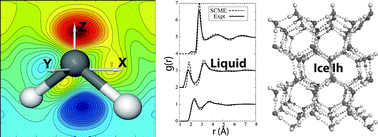A transferable H2O interaction potential based on a single center multipole expansion: SCME
Abstract
A transferable potential energy function for describing the interaction between

* Corresponding authors
a
Science Institute of the University of Iceland, VR-III, 107, Reykjavík, Iceland
E-mail:
wikfeldt@hi.is
b Nordita, KTH Royal Institute of Technology, Stockholm University, Roslagstullsbacken 23, SE 106 91 Stockholm, Sweden
c Department of Chemistry, University of Washington, Seattle, WA 98195, USA
d Faculty of Physical Sciences, VR-III, University of Iceland, 107, Reykjavík, Iceland
A transferable potential energy function for describing the interaction between

 Please wait while we load your content...
Something went wrong. Try again?
Please wait while we load your content...
Something went wrong. Try again?
K. T. Wikfeldt, E. R. Batista, F. D. Vila and H. Jónsson, Phys. Chem. Chem. Phys., 2013, 15, 16542 DOI: 10.1039/C3CP52097H
To request permission to reproduce material from this article, please go to the Copyright Clearance Center request page.
If you are an author contributing to an RSC publication, you do not need to request permission provided correct acknowledgement is given.
If you are the author of this article, you do not need to request permission to reproduce figures and diagrams provided correct acknowledgement is given. If you want to reproduce the whole article in a third-party publication (excluding your thesis/dissertation for which permission is not required) please go to the Copyright Clearance Center request page.
Read more about how to correctly acknowledge RSC content.
 Fetching data from CrossRef.
Fetching data from CrossRef.
This may take some time to load.
Loading related content
